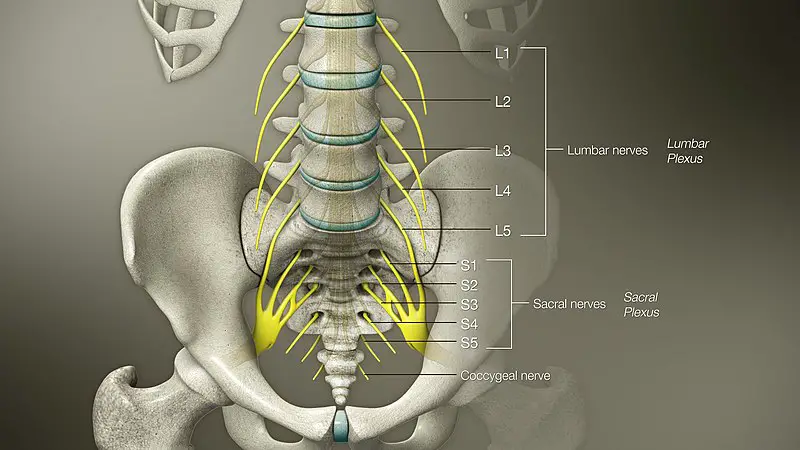Article reviewed and approved by Dr. Ibtissama Boukas, physician specializing in family medicine
The lumbar plexus is a network of nerve fibers whose role is to innervate the skin and muscles of the lower limb. What is the lumbar plexus, exactly, and how does it relate to back pain and more neuropathic pain ? This article explains the anatomy and the role of this plexus, and makes the connection with certain clinical conditions.
Definition and anatomy
To understand the lumbar plexus (also called the lumbar plexus), one must know the anatomy of the spine, vertebrae which compose it, the spinal cord and the spinal nerves which emerge from it.
Let's start with the spinal nerves (also called spinal nerves). After originating from the spinal cord, they pass through the intervertebral foramen of their corresponding vertebra. Each nerve then divides into anterior and posterior nerve branches.
Spinal nerves L1 to L4 form the origin of the lumbar plexus. More specifically, the lumbar plexus begins with the anterior fibers of the L1, L2, L3, and L4 spinal nerves. He also receives a branch of the 12e thoracic nerve, and the L4 spinal nerve also participates in the lumbosacral plexus.
After being separated into various branches, the fibers of the lumbar plexus combine to form 6 main peripheral nerves. These nerves then descend along the posterior abdominal wall to reach the lower limb, where they perform their role of sensory and motor innervation (i.e. providing sensation and enabling movement of the legs).
Here are the 6 peripheral nerves having connected to the lumbar plexus:
- Iliohypogastric nerve (formerly called greater abdomino-genital nerve)
- Ilioinguinal nerve
- Genitofemoral nerve (formerly called genitocrural nerve or external pudendal nerve)
- Lateral cutaneous nerve of the thigh (formerly called femorocutaneous nerve)
- Obturator nerve
- crural nerve (or femoral)
Together, these nerves provide sensory innervation to the region of the trunk, abdominal wall, genitals, and thighs. They also allow the muscular contraction of certain surrounding muscles (such as the transverse abdominal, the obliques or the adductors).
We therefore understand that damage to the brachial plexus can cause pathologies and disorders that greatly affect function.
Pathologies associated with the lumbar plexus
As mentioned, irritation of the lumbar plexus can cause pain and other nervous disorders. Here are the pathologies concerned:
- Herniated disc
- Meralgia paresthetica
- Traumatic damage to peripheral nerves
The symptoms that can be observed are pain in the innervated region, tingling, numbness, burning sensation, weakness of the lower limbs, etc.
Treatment
In terms of treatment, this will depend on the precise diagnosis. Anatomical knowledge will thus make it possible to determine the affected peripheral nerve. For example, involvement in the front of the thigh associated with weakness in the quadriceps and numbness in the front of the leg raise suspicion of nerve damage. cruralgia.
To know everything about cruralgia (damage to the crural or femoral nerve), see the following article.
This knowledge will also make it possible to make the difference between a peripheral attack and a central attack of the nervous system which constitutes a medical emergency (and sometimes surgical).
To determine if the symptoms are due to serious spinal damage, see the following article: Back pain: When should you worry?
Obviously, a medical imaging exam (such as a Lumbar MRI) will clarify the diagnosis, and better identify the pathological area.

